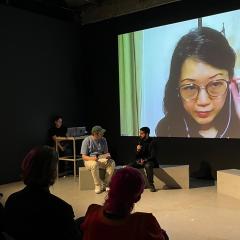
What do Thomas Hardy's poetry, cinema's femmes fatale, Hugo Chávez and Breaking Bad have in common?
Answer: A book on each is by a Communication and Arts graduate from their PhD and M Phil theses. As School Director of Research Higher Degrees, A/Professor Jane Stadler put it ‘there is no better advertisement for the value of a School of Communication and Arts thesis than the 6 research higher degree theses that were turned by their authors into scholarly books in 2015’. On the 6th November the School staged a special joint Research and Research Higher Degree seminar in honour of this achievement. Four of the six authors—Indy Clark, Samantha Lindop, Elliott Logan and Elena Block—spoke to their books followed by a discussion of the life of research after thesis submission. They joined in this discussion by members of their research supervision team. Of our other two authors, Anna Potter, who works at the University of the Sunshine Coast, was awarded a Discovery Early Career Researchers Award in the latest round to pursue a follow-up study of her pioneering work on Australian children’s television undertaken for her Communication and Arts PhD; while Steven Gil who is currently a post-completion fellow in the School has recently become co-editor of a new journal, Journal of Science and Popular Culture, published by Intellect.
Elena Block spoke to her book Political Communication and Leadership: Mimetisation, Hugo Chávez and the Construction of Power and Identity, which is a major study of controversial Venezuelan President the late Hugo Chávez. This monograph joins up all the elements involved in Chavez’s political communication style: 'hegemony and identity construction, political culture, populism, mediatisation and communicational government'.
Indy Clark, in Thomas Hardy’s Pastoral: An Unkindly May, read Hardy's poetry of the rural as deeply rooted in the historical tradition of the pastoral mode even as it complicates and extends it through Hardy’s heightened awareness of complex communities and the relations of class, labour, and gender.
Samantha Lindop’s Postfeminism and the Fatale Figure in Neo-Noir Cinema traces the cinematic history of the femme fatale by also taking into account the lesser known counterparts, the fille fatale and homme fatal. She considered the multifaceted interactions between the histories, origins, and conventions of characters and genres, and the way these interweave in contemporary cinematic interpretations.
Elliott Logan spoke to Breaking Bad and Dignity: Unity and Fragmentation in the Serial Television Drama, which is the first book-length, single-authored study to examine Breaking Bad in detail across each of its five seasons. Logan argued that its design and significance as a television serial both originate from the show's seasons taking shape around a set of dramatic stakes related to the characters' desires for dignity.
Anna Potter’s Creativity Culture and Commerce: Producing Australian Children’s Television with Public Value provides the authoritative analysis of the creative, economic, regulatory, and technological factors that shape the production of contemporary Australian children’s television for digital regimes. Potter’s book charts the complex new settlements in children’s television that developed from 2001 to 2014 and describes the challenges inherent in producing culturally specific screen content for global markets. It also calls for new public debate around the provision of high-quality screen content for children, arguing that the creation of public value must sit at the centre of these discussions.
Steven Gill’s Science Wars through the Stargate: Explorations of Science and Society in Stargate SG-1 offers the first in-depth analysis of the series and places it in the context of contemporary debates about the nature of scientific thought. Gil’s book contends that representations of science within SG-1 can be more fully understood through the prism of the Science Wars. Scientific ideas put forth in SG-1demonstrate how such complex intellectual exchanges and debates have a place in popular culture and can be further understood through these fictional articulations. Although SG-1 serves as the principal case study, the analysis also casts light on the role and position of science in science fiction television more generally.
Creative Writing research higher degrees students also publish a number of novels, plays, and other creative works each year, to the credit of the School of Communication and Arts.



